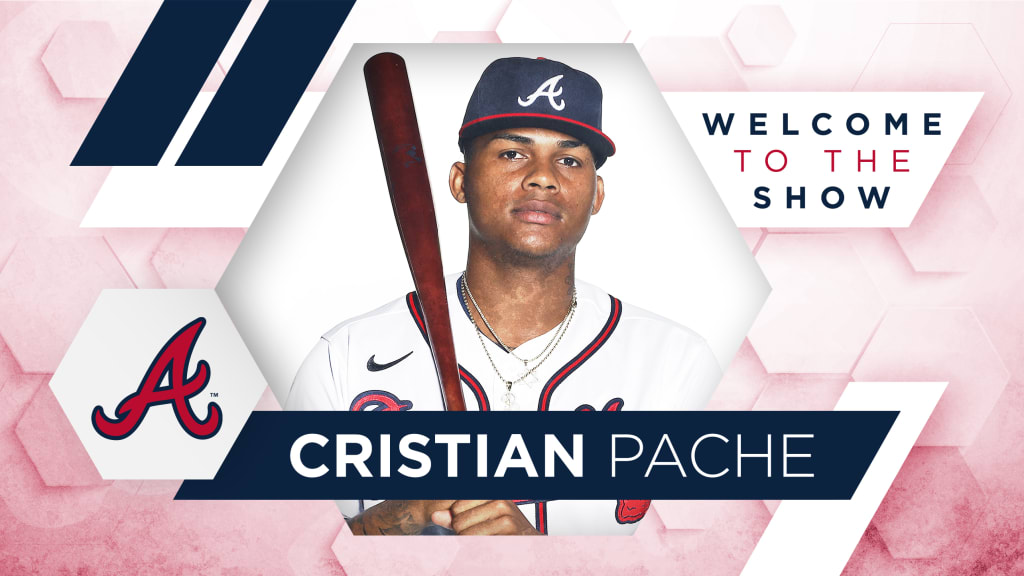
For the last couple of years, Braves fans have been dreaming of having a young, dynamic trio of outfielders roaming Truist Park. Ronald Acuña Jr. obviously got things started, but excitement was building to have him joined by top prospects Cristian Pache and Drew Waters.
Now, partially because of Acuña’s absence, Pache is getting his first chance at playing in the big leagues. Both he and Waters have been working out at the team’s alternate site and when Acuña’s wrist injury forced a move to the injured list, buzz about Pache, the game’s No. 14 overall prospect, getting called up grew. When Nick Markakis landed on the IL as well as a precaution because he had been exposed to someone with COVID-19, the promotion became a necessity.
And while it’s possible Pache’s stay could be brief -- Markakis could be reinstated quickly -- there’s also reason to believe he could get a chance to show what he can do. While current center fielder Ender Inciarte does have a modest three-game hitting streak going, he’s still managed just a .226/.304/.258 line. Pache’s calling card early on has been his defense, for good reason, and he’s the only hitter in the Top 100 with three 70 grades. But his offense has improved as he’s developed and could provide a boost in the lineup should the Braves allow him to stick around even when Acuña and Markakis return.
Here’s what the 21-year-old Pache brings to the table for the Braves, with his grades on the 20-to-80 scouting scale in parentheses (20-30 is well below average, 40 is below average, 50 is average, 60 is above average and 70-80 is well above average):
Hit (55): Pache’s approach has improved even though he’s moved very quickly up the Braves’ ladder. He’s learned to see more pitches and draw more walks -- his 8 percent walk rate in 2019 was his career high, despite being just 20 and reaching Triple-A, where he walked more and struck out less than he did in Double-A -- with his .340 on-base percentage in 2019 a high in his three years of full-season ball. He can drive the ball to all fields and makes a ton of hard contact.
Power (50): His extra-base authority is showing up more and more consistently, and Pache set career highs in 2019 in home runs, doubles, slugging percentage and OPS. His ISO (isolated power) has gone from .062 in his first taste of full-season ball in 2017 to .131 in 2018 and up to .185 a year ago. Most of his home run power is to his pull side, but he’s only going to get stronger.
Run (70): While Pache’s nearly top-of-the-scale speed helped him steal 32 bases back in 2017, he hasn’t been a threat to run the last two seasons, but that’s not a sign of him slowing down. He can still leg out hits and take extra bases. And his wheels allow him to cover a ridiculous amount of ground in center field.
Arm (70): Back in 2017, before people really knew what kind of arm Pache had, he racked up 17 assists in the South Atlantic League, all from center field. Runners learned quickly not to run on him, so his assist totals -- seven in 2018 and nine in 2019 -- went down. It’s as strong an arm as there is among outfield prospects and would profile really well in right field, except for the fact that he’s perhaps the best defensive prospect in baseball.
Field (70): Pache was chosen as MLB Pipeline’s top defensive prospect two years in a row, prior to the 2019 and 2020 seasons, and he was named the top defender by executives in a January Pipeline Poll. Not only does his speed allow him to chase down balls, he has incredible instincts, reads and routes, with one teammate saying he seems to take his first step before the ball is hit. He’s a Gold Glove caliber outfielder the second he sets foot in Atlanta’s outfield, one who’ll make Acuña, and eventually Waters, man the corners.



